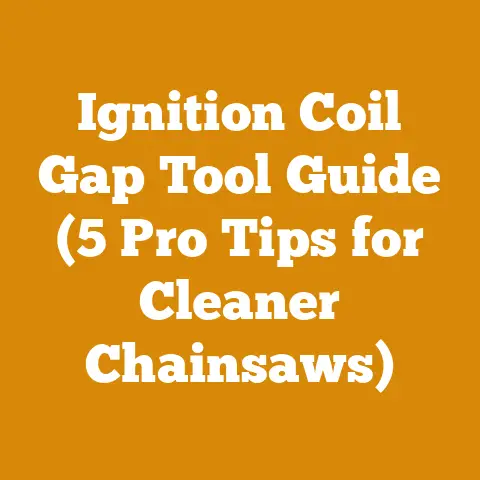Easy Start Firewood Processors (5 Pro Tips for Smooth Splitting)
Conquer the Cord: Your Guide to Easy Start Firewood Processors and Cost-Effective Splitting
Firewood. It’s the heart of a cozy winter, the fuel for countless campfires, and, for some, a livelihood. But splitting wood can be back-breaking work. That’s where firewood processors come in. They promise to turn timber into ready-to-burn fuel with ease. But before you jump in and buy one, let’s talk about getting the most bang for your buck. This article is all about understanding the costs involved in firewood processing, especially when using an “easy start” machine, and how to make smart, informed decisions. I’ll share my experiences, data-driven insights, and practical tips to help you conquer the cord without breaking the bank.
Understanding the Allure of “Easy Start”
The term “easy start” is a major draw, especially for those new to firewood processing. These machines are generally designed to be user-friendly, often featuring simplified controls and lighter construction compared to heavy-duty industrial processors. They’re marketed towards homeowners, small-scale firewood businesses, and those who want a more manageable way to prepare their winter fuel.
However, “easy start” doesn’t always equate to “cheap.” While the initial purchase price might be lower than professional-grade models, you need to consider the whole picture: long-term running costs, maintenance, and the machine’s limitations.
Pro Tip #1: Know Your Wood – It Dictates Everything
Before even thinking about a processor, understand the wood you’ll be working with. This single factor dramatically influences your equipment needs and, ultimately, your costs.
- Species Matters: Hardwoods like oak, maple, and hickory are denser and require more splitting force than softwoods like pine, fir, and spruce. An “easy start” processor might struggle with consistently splitting large rounds of oak. This can lead to increased processing time, potential damage to the machine, and, in the long run, higher maintenance costs.
- Size and Shape: Knotty, twisted logs are a nightmare for any splitter, including those with “easy start” features. Aim for straight, relatively knot-free logs. The larger the diameter of the rounds you plan to process, the more powerful the processor you’ll need. Many “easy start” models have limitations on the maximum log diameter they can handle.
- Moisture Content: Green wood is notoriously harder to split than seasoned wood. Splitting green wood puts extra strain on the processor and increases wear and tear. Ideally, you should let your wood season for at least six months before processing.
My own experience taught me this lesson the hard way. Early on, I tried to split a particularly gnarly oak log with an underpowered splitter. The machine strained, the hydraulic fluid overheated, and I ended up spending a small fortune on repairs. Now, I carefully select my logs, prioritize seasoned wood, and pre-split excessively large or knotty pieces with a maul before feeding them into the processor.
Pro Tip #2: Decoding the “Easy Start” Price Tag – Beyond the Sticker
The initial purchase price of an “easy start” firewood processor is just the tip of the iceberg. Here’s a breakdown of the cost factors you need to consider:
- Initial Investment: This includes the purchase price of the processor itself, plus any accessories like log lifts, conveyors, or additional splitting wedges. Prices for “easy start” models typically range from \$2,000 to \$10,000, depending on features and capacity.
- Fuel Costs: Most “easy start” processors are powered by gasoline engines. Fuel consumption varies depending on the engine size, the type of wood you’re processing, and how efficiently you operate the machine. A rough estimate is 0.5 to 1 gallon of gasoline per hour. With gasoline prices averaging around \$4 per gallon (depending on location and seasonal fluctuations), fuel costs can quickly add up.
- Maintenance Costs: This includes routine maintenance like oil changes, filter replacements, spark plug replacements, and sharpening the splitting wedge. “Easy start” machines, while simpler in design, still require regular maintenance to ensure optimal performance and longevity. I budget approximately \$100-200 per year for routine maintenance on my processor.
- Repair Costs: Even with proper maintenance, breakdowns can happen. Repair costs can range from minor fixes like replacing a hydraulic hose to major overhauls like replacing the engine or hydraulic pump. A good rule of thumb is to set aside 5-10% of the initial purchase price per year for potential repairs.
- Labor Costs: If you’re hiring someone to operate the processor, you’ll need to factor in their hourly wage. Labor costs vary depending on location and experience, but a reasonable estimate is \$15-25 per hour.
- Depreciation: Like any piece of equipment, a firewood processor depreciates over time. This means its value decreases as it gets older and more worn. The rate of depreciation depends on the machine’s quality, how well it’s maintained, and how often it’s used.
- Opportunity Cost: This is the value of the next best alternative you forgo when you choose to invest in a firewood processor. For example, if you could earn \$50 per hour working a different job, the opportunity cost of spending an hour processing firewood is \$50.
Data Point: According to a survey by the U.S. Department of Agriculture, the average cost to produce a cord of firewood ranges from \$80 to \$200, depending on location, wood type, and equipment used. This figure includes all the cost factors mentioned above.
Case Study: I know a small-scale firewood seller who initially invested in a low-cost “easy start” processor. While the initial price was appealing, the machine broke down frequently, requiring expensive repairs and causing significant downtime. He eventually upgraded to a more robust processor, which, while more expensive upfront, proved to be a more cost-effective solution in the long run due to its reliability and efficiency.
Pro Tip #3: The Labor Equation – DIY vs. Hiring Help
Labor is a significant cost factor in firewood processing. You have two main options: do it yourself or hire someone to help.
- DIY: Processing firewood yourself saves you money on labor costs, but it requires a significant time commitment and can be physically demanding. It’s crucial to factor in your own time and energy when calculating the true cost of DIY firewood processing.
- Hiring Help: Hiring someone to operate the processor can free up your time and reduce the physical strain. However, it adds to your overall costs. When hiring, consider factors like experience, reliability, and insurance coverage.
My Experience: I’ve done both DIY and hired help. When I was younger and had more time, I handled most of the firewood processing myself. Now, with a busier schedule, I often hire a local handyman to help with the heavier tasks like loading logs and stacking firewood.
Calculations: Let’s say you can process one cord of firewood in 8 hours using an “easy start” processor. If you value your time at \$20 per hour, the labor cost for DIY processing is \$160 per cord. If you hire someone at \$15 per hour, the labor cost is \$120 per cord.
Cost Comparison Table:
| Task | DIY Cost (per cord) | Hired Help Cost (per cord) |
|---|---|---|
| Labor | \$160 | \$120 |
| Other Costs (Fuel, Maintenance, etc.) | \$40 | \$40 |
| Total | \$200 | \$160 |
In this scenario, hiring help is actually cheaper, assuming you value your time at \$20 per hour. However, this is just an example. The actual costs will vary depending on your specific circumstances.
Pro Tip #4: Mastering Maintenance – The Secret to Longevity
Proper maintenance is crucial for extending the life of your “easy start” firewood processor and minimizing repair costs. Here’s a maintenance checklist:
- Regular Oil Changes: Change the engine oil and hydraulic fluid according to the manufacturer’s recommendations. This keeps the engine and hydraulic system running smoothly and prevents premature wear.
- Filter Replacements: Replace the air filter, fuel filter, and hydraulic filter regularly. Clean filters ensure optimal performance and prevent contaminants from damaging the engine and hydraulic system.
- Spark Plug Replacement: Replace the spark plug annually. A new spark plug ensures proper combustion and improves engine efficiency.
- Wedge Sharpening: Sharpen the splitting wedge regularly. A sharp wedge makes splitting easier and reduces strain on the processor.
- Greasing: Grease all moving parts regularly. This reduces friction and prevents wear.
- Inspection: Inspect the processor regularly for loose bolts, worn hoses, and other potential problems. Address any issues promptly to prevent them from escalating into more serious repairs.
Data Point: According to a study by the National Firewood Association, processors that are properly maintained have a lifespan that is 30-50% longer than those that are neglected.
Tip: Keep a detailed maintenance log. Record all maintenance tasks performed, including dates, parts used, and costs. This helps you track your maintenance expenses and identify potential problems early on.
Pro Tip #5: Scaling Up or Down – Matching the Machine to the Task
“Easy start” firewood processors are typically designed for smaller-scale operations. If you’re processing a large volume of firewood, a more robust, industrial-grade processor might be a better investment.
- Assess Your Needs: How much firewood do you need to process each year? What size logs will you be working with? How much time do you have available for processing? Answering these questions will help you determine the appropriate size and type of processor for your needs.
- Consider Future Growth: If you plan to expand your firewood business in the future, you might want to invest in a processor that can handle increased volume.
- Rent Before You Buy: Before purchasing a processor, consider renting one to see if it meets your needs. This allows you to test out different models and determine which one is the best fit for your operation.
Industry Benchmarks:
- Small-Scale: “Easy start” processors are suitable for processing up to 10 cords of firewood per year.
- Medium-Scale: Mid-range processors are suitable for processing 10-50 cords of firewood per year.
- Large-Scale: Industrial-grade processors are suitable for processing 50+ cords of firewood per year.
The Sweet Spot: I’ve found that for personal use and selling a small amount of firewood (around 5-10 cords a year), a well-maintained “easy start” processor is a good balance of cost and convenience. However, if I were looking to scale up significantly, I’d definitely consider investing in a more powerful machine.
Optimizing Costs and Boosting Efficiency
Here are some additional tips for optimizing costs and boosting efficiency in firewood processing:
- Source Wood Strategically: Explore different sources for your wood. Consider purchasing logs directly from loggers, salvage logging, or even urban tree removal. Negotiate prices based on volume and quality.
- Season Wood Properly: Seasoning wood reduces its moisture content, making it easier to split and burn. Stack wood properly to allow for good air circulation.
- Minimize Waste: Cut firewood to the appropriate length to minimize waste. Use leftover pieces for kindling.
- Maintain Sharp Chainsaws: A sharp chainsaw makes it easier to buck logs into manageable lengths. Sharpen your chainsaw chain regularly.
- Work Safely: Always wear appropriate safety gear, including eye protection, hearing protection, gloves, and steel-toed boots. Work in a safe and well-lit area.
Actionable Takeaways
- Know your wood: Understanding the species, size, and moisture content of the wood you’ll be processing is crucial for selecting the right equipment and optimizing your costs.
- Factor in all costs: Don’t just focus on the initial purchase price of the processor. Consider fuel, maintenance, repair, labor, depreciation, and opportunity costs.
- Master maintenance: Regular maintenance is essential for extending the life of your processor and minimizing repair costs.
- Scale appropriately: Choose a processor that is appropriate for the volume of firewood you plan to process.
- Optimize efficiency: Source wood strategically, season it properly, minimize waste, and work safely.
The Final Spark: Making the Right Choice
Investing in a firewood processor can be a game-changer, turning a back-breaking chore into a more manageable task. But it’s crucial to approach the decision with a clear understanding of the costs involved. By carefully considering your needs, researching different models, and implementing smart cost-saving strategies, you can conquer the cord without burning a hole in your wallet. Remember, the goal is to find the sweet spot where efficiency, cost-effectiveness, and personal satisfaction meet. Now, go forth and split!






